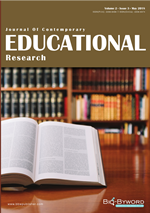Aliteracy Among Teachers? Investigating the Reading Habits of Elementary and Early Childhood Educators
Abstract
Abstract: Since the reading habits of both preservice and inservice teachers have been linked to their abilities as reading teachers, aliteracy among teachers is particularly distressing. The purpose of this study was to investigate the amount of leisure time elementary teachers spend reading literature for pleasure. Prekindergarten through sixth grade teachers (N=24) enrolled in a graduate education course logged the minutes they spent engaged in various leisure activities during one week of the summer. Reading literature, defined as the reading of novels, short stories, plays, or poetry in one’s spare time, ranged from 0 to 845 minutes. Of the 13 activities investigated, the highest average amount of time was spent watching movies (M=552.92). Reading literature for pleasure had the eighth highest mean (M=123.13). Pairwise comparisons revealed no significant difference (t = -.795, p < .435) between time spent reading literature and time spent in other non-literature leisure activities. Results or paired samples t-tests indicated that participants spent significantly less time reading newspapers/magazines (t = 2.696, p < .013) and reading blogs (t = 2.783, p < .011) and significantly more time watching movies (t = -3.287, p < .003) than reading literature for pleasure. It appears that lack of motivation may be a factor in participants’ decision to read literature for pleasure as opposed to either lack of time or technological distractions.
References
UNESCO Institute of statistics (2012) Adult and youth literacy (pp. 1–4): United Nations
Educational, Scientific and Cultural Organization.
Clark, Christina and Kate Rumbold (2006). ‘Reading for pleasure: A research overview’. London, National Literacy Trust. Retrieved form https://files.eric.ed.gov/fulltext/ED496343.pdf
Kittle, Penny and Kelly Gallagher (April 4, 2018). ‘Reimagining reading: Connecting and promoting lifelong readers through book clubs’. https://www.literacyworldwide.org/blog/literacy-daily/2018/04/04/reimagining-reading-connecting-and-promoting-lifelong-readers-through-book-clubs?utm_source=TW-04102018&utm_medium=email&utm_campaign=ThisWeek&utm_content=Story-1
Chong, S. L. (2016). ‘Re-thinking aliteracy: when undergraduates surrender their reading choices’. Literacy, 50(1), 14-22. doi:10.1111/lit.12063
Cohen, S. (July 16, 2015). The rise of “aliteracy.†Aculturated. Retrieved form
https://acculturated.com/the-rise-of-aliteracy/
Good, Alex (March 16, 2017). The rising tide of educated aliteracy. The Walrus.
https://thewalrus.ca/the-rising-tide-of-educated-aliteracy/
Benevides, T. & Peterson, S. S. (2010). ‘Literacy attitudes, habits and achievements of future teachers’. Journal of Education for Teaching, 36(3), 291–302.
Nathanson, Steven, John Pruslow, and Roberta Levitt (2008). ‘The reading habits and literacy attitudes of inservice and prospective teachers: Results of a questionnaire survey’. Journal of Teacher Education, 59, 313-321.
Morrison, Timothy G., James S. Jacobs, and William R. Swinyard (1999). ‘Do teachers who read personally use recommended literacy practices in their classrooms?’ Reading Research and Instruction, 38(2), 81-100.
Gambrell, L. B., (1996). Creating classroom cultures that foster reading motivation. The Reading Teacher, 50(1), 14-25.
Turner, Jennifer D., Mary Dekonty Applegate, and Anthony J. Applegate (2009). ‘Teachers as literacy leaders’. The Reading Teacher, 63(3), 254-256.
Mikulecky, Larry (1978). ‘Aliteracy and a changing view of reading goals’. Paper presented at the annual meeting of the International Reading Association Houston, Texas. (ERIC Document Reproduction Service No. ED 157 052)
Bauerlein, Mark. (2008). The Dumbest Generation. Los Angeles: Tarcher.
Schultz, Kathryn. (June 24, 2011). What Is Distant Reading? New York Times. https://www.nytimes.com/2011/06/26/books/review/the-mechanic-muse-what-is-distant-reading.html
Baumann, James F. and Amy M. Duffy (1997). Engaged reading for pleasure and learning: A report from the National Reading Research Center. Washington, DC: Office of Educational Research and Improvement. Retrieved from https://files.eric.ed.gov/fulltext/ED413579.pdf
Nikolajeva, Maria (2010). ‘Literacy, competence and meaning making: a human sciences approach’. Cambridge Journal of Education, 40(2), 145–159.
Willingham, Danielle T. (2015). ‘For the love of reading: Engaging students in a lifelong pursuit’. American Educator, 39(1), 4-13.
Goctu, Ramazan (2016). ‘The impact of reading for pleasure on Georgian university EFL students' reading comprehension’. Journal of Education in Black Sea Region, 1(2), 73-81.
Sullivan, A. (2002) Bourdieu and education: How useful is Bourdieu’s theory for researchers? Netherlands’ Journal of Social Sciences, 38(2), 144–166.
Sullivan, A. (2007) Cultural capital, cultural knowledge, and ability. Sociological Research Online, 12 (6): Article 1. doi:10.5153/sro.1596.
Guthrie, John T. and Donna E. Alvermann (1999). Engaged reading: Processes, practices, and policy implications. New York: Teachers College Press.
Cunningham, A., & Stanovich, K. E. (2001). What reading does for the mind. Journal of Direct Instruction, 1(2), 137-149.
Krashen, Stephen D. (2004). The Power of Reading: Insights from the Research. Portsmouth, CT: Reed Elsevier.
Sullivan, Alice and Mathew Brown (2015). Reading for pleasure and progress in vocabulary and mathematics. British Educational Research Journal, 41(6), 971-991. doi:10.1002/berj.3180
Sanacore, J. (2002). Struggling literacy learners benefit from lifetime literacy efforts.
Reading Psychology, 23, 67-86.
Haverback, Heather Rogers (2013-2014). ‘Where does the time go? Reading for Pleasure and Inservice Teachers’. The Reading Professor, 36(1), 32-37.
National Endowment for the Arts (NEA). (2004). Reading at risk: A survey of literary reading in America. Retrieved from http://www.nea.gov/pub/ReadingAtRisk.pdf
Armstrong, R. A. (2014). ‘When to use the Bonferroni correction’. Ophthalmic and Physiological Optics, 34, 502-508. doi:10.1111/opo.12131
Perneger, T. V. (1998). ‘What's wrong with Bonferroni adjustments?’ BMJ, 316, 1236-1238. doi.org/10.1136/bmj.316.7139.1236
Harrison, Bev (2012). ‘Reading for pleasure among year 13 boys: What are the possibilities and problems?’ Kairaranga, 13(2), 41-48.
Rothbauer, Pauletta (2009). ‘Exploring the placelessness of reading among older teens in a Canadian rural municipality’. The Library Quarterly, 79(4), 465- 483.
Baker, Linda and Deborah Scher (2002). ‘Beginning readers’ motivation for reading in relation to parental belies and home reading experiences’. Reading Psychology, 23, 239-269.

